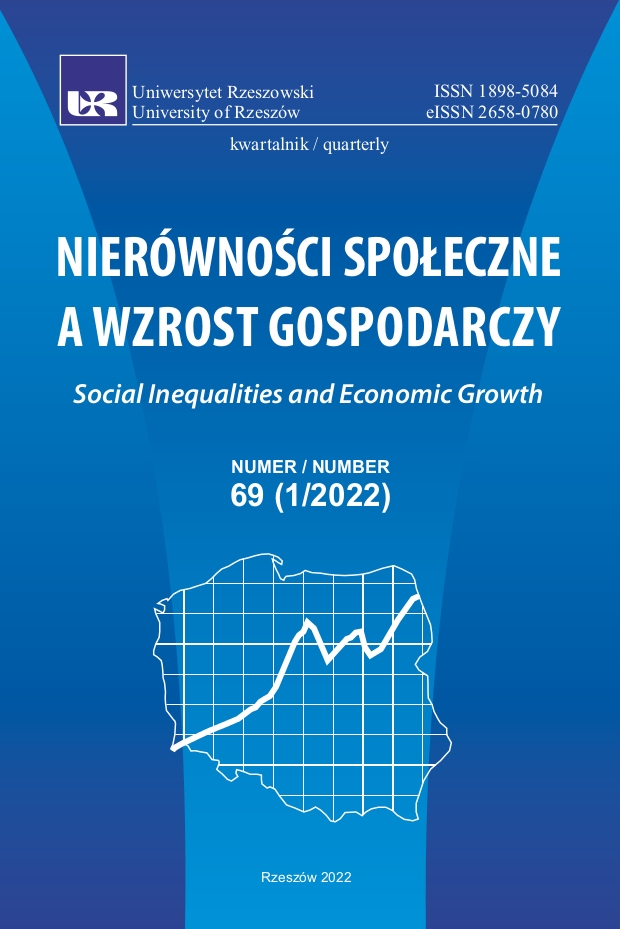Bezpieczeństwo mieszkaniowe jako wskaźnik środowiska życia
DOI:
https://doi.org/10.15584/nsawg.2022.1.6Słowa kluczowe:
bezpieczeństwo mieszkaniowe, jakość życia, środowisko życia, zróżnicowanie regionalneAbstrakt
Mieszkanie jest jedną z podstawowych wartości, które zapewniają obywatelom poczucie stabilności i bezpieczeństwa ekonomicznego, a także stymulują ich do produktywnej pracy. Mieszkanie jest ważnym elementem jakości środowiska życia na Białorusi. W Republice istnieje jednak problem z zapewnieniem ludności wygodnych i niedrogich mieszkań. Regionalne różnice w bezpieczeństwie mieszkaniowym zidentyfikowane zarówno pomiędzy krajami, jak i pomiędzy regionami w kraju, wynikają z faktu, że różne terytoria mają szereg wyróżniających cech społeczno-ekonomicznych, przyrodniczo-geograficznych i ekologicznych. Różnice te obejmują: – w kraju jest to różnica w położeniu gospodarczym i geograficznym regionów rolniczych pod względem żyzności gleb pod uprawę niektórych roślin rolniczych; skażenie radioaktywne niektórych terytoriów Białorusi, poziom ich rozwoju; – różnicę między krajami tłumaczy się różnym poziomem rozwoju społeczno-gospodarczego terytoriów, poziomem życia ludności, różnicami w rozwoju sfery bankowej i finansowej oraz kredytowej, przemysłem regionów, przejrzystością informacji w sektorze mieszkaniowym oraz szeregiem innych czynników. Powyższe obserwacje potwierdziła analiza wskaźnikowa bezpieczeństwa mieszkaniowego ludności regionów Białorusi oraz analiza skupień agregatu krajów WNP.
Downloads
Bibliografia
Babosova, E. S., Mamedov, A. K., Panich, N. A. (2015).The innovations in the theories of T. Parsons at the turn of the XX-XXI centuries. Moscow State University Bulletin Series 18. Sociology and Political Science, 3, 5–23. DOI: 10.24290/1029-3736-2015-0-3-5-23.
Barker, K. (2004). Delivering stability: securing our future housing needs. Barker Review of Housing Supply. Final Report – Recommendations. London: ODPM Literature.
Belarus and the countries of the world: stat. book. (2020). Minsk: National Statistical Committee of the Republic of Belarus.
Bell, D. (1973). The coming of post-industrial society: A venture of social forecasting. New York: Basic Books.
Bestuzhev-Lada I. V., Batygin G. S., Grishaeva N. P. (1978). The category of “quality of life” in modern Western sociology. In: Modern concepts of level, quality and lifestyle (pp. 142–159). Moscow: Institute of Sociological Research of the Academy of Sciences of the USSR.
Campbell, A., Converce, P. E., Rodgers, W. L. (1976). The Quality of American Life. New York: Russell Sage Foundation.
Constitution of the Republic of Belarus. (1994).Retrieved from:https://www.constituteproject.org/constitution/Belarus_2004.pdf?lang=en (2021.02.20).
Daniell, J., Puzanov, A., Struyk R. (1993). Housing Quality in Moscow and the Beginning of Sector Reform. Moscow: Urban Institute Technikal Cooperation Office.
Davydov, A. A. (2008). Competitive advantages of systems sociology. Moscow: IS RAS.
Galbraith, J. K. (2008). The New Industrial State. Moskow: Eksmo.
Genkin, B. M. (2008). Economics and sociology of labor: textbook. for universities. - 8th ed. add. Moskow: Norma.
Green, R. K., Malpezzi, S. (2003). A Primer on U.S. Housing Markets and Housing Policy. Washington: AREUEA Monographs, The Urban Institute Press.
Hoekstra, J. (2010). Divergence in European housing and welfare systems. Amsterdam: IOS Press.
Hoekstra, J. S. (2003). Housing and the Welfare State in the Netherlands: an Application of Esping Andersen’s Typology. Housing, Theory and Society, 20(2), 58–71.DOI: 10.1080/14036090310000634.
Holmans, A., Whitehead, Ch., Scanlon, K. (2010). Fiscal Policy instruments to promote affordable housing. London: LSE Research outline.
Housing Code of the Republic of Belarus dated August 28, 2012 No. 428-З (Adopted by the House of Representatives on May 31, 2012. Approved by the Council of the Republic on June 22, 2012). Codes of the Republic of Belarus. Retrieved from: https: //xn----htbdbkahjcdxp6bzg5a.xn--90ais/ (2021.02.20).
Housing stock and housing conditions of the population in the Commonwealth countries. (2021). Retrieved from: http://www.cisstat.com/base/base1/doclad20.htm/ (2021.06.20).
International Covenant on Economic, Social and Cultural Rights. (1964).Retrieved from: https://www.ohchr.org/en/instruments-mechanisms/instruments/internationalcovenant-conomic-social-and-cultural-rights (2021.02.20).
Kosareva, N. B., Polidi, T. D., Puzanov, A. S. (2015). Housing Policy and Economy in Russia: Results and Development Strategy. Moscow: NRU HSE.
Levy, L., Anderson, L. (1979). Population, environment and quality of life: trans. from English. Moscow: Economics.
Moroz, L. N., Kuznetsov, M. G., Shashko, T. D.(2006). Organizational-economic and legal problems of housing construction in the Republic of Belarus. Spirituality, Society, Personality, State, 1, 62–70.
National Statistical Committee. Official statistics (Electronic resource). Retrieved from: https://www.belstat.gov.by/ofitsialnaya-statistika/solialnaya-sfera/zhilischnyeusloviya/godovye-dannye/ (2021.08.03).
Petropavlova, G. P. (2011). The content of the category “quality of life” in science and use in the practice of territorial management. Economics and Environmental Management, 1(8), 21–40.
Social Progress Index rankings. (2020). Retrieved from: https://www.google.com/search?q=Social+Progress+Index+rankings%2C+2020%C2%BB&rlz=1C1GCEA_enBY904BY904&oq=Social+Progress+Index+rankings%2C+2020%C2%BB&aqs=chrome..69i57j0i22i30l2.1666j0j7&sourceid=chrome&ie=UTF-8/ (2021.08.27).
Statistical Yearbook of the Republic of Belarus: stat. collection. (2021). Minsk: National Statistical Committee of the Republic of Belarus.
Struyk, R. J., Damon M., Haddaway, S. R. (2010). Evaluating Capacity Building for Policy Research Organizations. American Journal of Evaluation, 32(1), 50–69. DOI: 10.1177/1098214010378355.
Toffler, A. (1990). Powershift: Knowledge, Wealth, and Violence at the Edge of the 21st Century. New York – London: Bantam Doubleday Dell Publishing Group.
UNECE (Electronic resource). Retrieved from: https://unece.org/fileadmin/DAM/hlm/documents/2010/ece.hbp.2010.6.r.pdf/ (2021.07.20).
Universal Declaration of Human Rights. (1948). Retrieved from: https://www.un.org/en/about-us/universal-declaration-of-human-rights (2021.02.20).
World development indicators. (2021). (Electronic resource). Retrieved from: https://datatopics.worldbank.org/world-development-indicators/ (2021.06.21).
Pobrania
Opublikowane
Jak cytować
Numer
Dział
Licencja

Utwór dostępny jest na licencji Creative Commons Uznanie autorstwa – Na tych samych warunkach 4.0 Miedzynarodowe.


